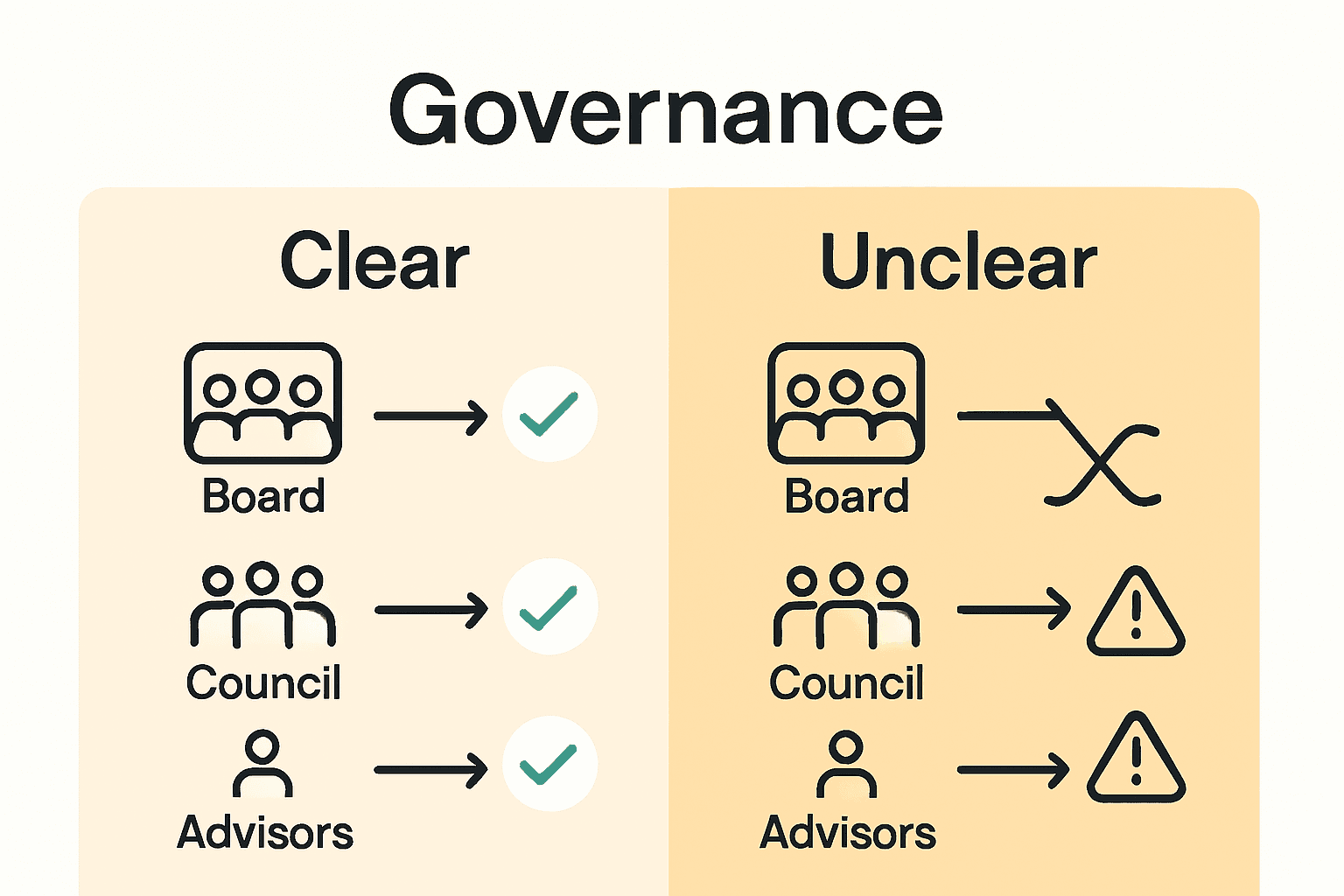Over $6 trillion in assets are controlled by family offices worldwide, yet only a small fraction successfully preserve both wealth and harmony across generations. Strong governance is the backbone that supports these outcomes. With families facing growing complexity and rapidly changing financial markets, understanding family office governance helps ensure money and relationships endure. This article provides a clear look at the frameworks and practices that shape lasting, resilient family legacies.
Table of Contents
- Defining Governance in Family Offices
- Types of Governance Structures Explained
- Key Roles and Decision-Making Processes
- Legal and Regulatory Frameworks Worldwide
- Mitigating Risks and Ensuring Compliance
Key Takeaways
| Point | Details |
|---|---|
| Governance Framework Importance | Effective governance structures underpin successful family wealth management by aligning organizational activities with family values and objectives. |
| Types of Governance Models | Different family office structures (Single, Multi, Hybrid, Virtual, Embedded) provide various benefits tailored to family needs and dynamics. |
| Role Clarity and Decision-Making | Clearly defined roles and decision-making processes enhance family harmony and strategic oversight within governance. |
| Regulatory Navigation | A comprehensive understanding of legal frameworks is essential for compliance and the optimization of operational strategies across jurisdictions. |
Defining Governance in Family Offices
Governance in family offices represents the strategic framework that transforms wealth management from a transactional process into a purposeful, multi-generational endeavor. According to Wealth DB, family governance centers on creating agreed processes for decision-making, implementing changes, and defining roles within both family and business contexts.
At its core, effective family office governance involves establishing clear structures that align organizational activities with the family’s core values and long-term objectives. Fiscal Solutions highlights that this process requires selective delegation to competent personnel and advisors while maintaining transparent communication channels that enable collective decision-making.
Key elements of robust family office governance typically include:
- Developing comprehensive succession planning strategies
- Creating transparent communication protocols
- Establishing clear decision-making hierarchies
- Defining individual and collective responsibilities
- Implementing systematic review and adaptation mechanisms
Successful governance goes beyond mere administrative protocols. It represents a holistic approach to preserving family wealth, maintaining familial harmony, and ensuring that financial strategies remain adaptive and aligned with evolving generational perspectives and market dynamics. By institutionalizing these governance frameworks, family offices can transform potential sources of conflict into collaborative opportunities for sustained wealth preservation and growth.
Types of Governance Structures Explained
Family office governance structures represent diverse approaches to managing wealth, each tailored to unique family dynamics and strategic objectives. According to Future Family Office, the primary models include Single-Family Offices, Multi-Family Offices, Hybrid Models, Virtual Offices, and Embedded Offices, each offering distinct benefits and strategic considerations.
Corient emphasizes that these structures differ significantly in their operational approaches, with key variations in service delivery, cost efficiency, and resource allocation. Embedded Family Offices, for instance, integrate services within larger business entities, while Multi-Family Offices leverage shared resources and expertise across multiple family units.
Let’s explore the primary governance structure types:
Here’s how the main family office governance structures compare:
| Structure Type | Key Characteristics | Advantages | Considerations |
|---|---|---|---|
| Single-Family Office | Dedicated to one family | Personalized Full control |
High cost Resource intensive |
| Multi-Family Office | Serves multiple families | Shared expertise Cost sharing |
Less privacy Standardization |
| Hybrid Model | Combines in-house & outsourcing | Flexible Scalable |
Complex coordination |
| Virtual Office | Technology-driven & remote | Lower cost Global access |
Digital security Less personal service |
| Embedded Office | Integrated within larger business | Resource efficiency Synergy |
Limited autonomy Possible conflicts |
- Single-Family Offices: Dedicated exclusively to one family’s comprehensive wealth management
- Multi-Family Offices: Collaborative platforms serving multiple families with shared professional resources
- Hybrid Models: Flexible structures combining in-house and outsourced wealth management capabilities
- Virtual Offices: Technology-driven platforms enabling remote wealth management and coordination
- Embedded Offices: Integrated units within existing corporate or business infrastructures
The selection of an appropriate governance structure depends on multiple factors, including family size, wealth complexity, generational dynamics, and strategic objectives. Families must carefully evaluate their specific needs, balancing personalization with operational efficiency, to design a governance framework that supports long-term wealth preservation and intergenerational harmony.

Key Roles and Decision-Making Processes
Effective family office governance hinges on establishing clear roles and strategic decision-making frameworks that balance family dynamics with professional management. According to Zephyr Groups, the primary governance bodies include the Board of Directors, which focuses on business and investment oversight, and the Family Council, which emphasizes family values alignment and interpersonal harmony.
Fiscal Solutions recommends creating a board composition that strategically blends senior family members with objective external advisors. This approach ensures comprehensive oversight, minimizes individual biases, and maintains alignment with the family’s long-term strategic interests.
Key governance roles typically include:
- Family Patriarch/Matriarch: Providing foundational vision and legacy guidance
- Board of Directors: Overseeing strategic investments and business operations
- Family Council: Managing interpersonal relationships and shared values
- Independent Advisors: Offering objective professional perspectives
- Next-Generation Representatives: Ensuring intergenerational engagement
Successful decision-making processes require transparent communication protocols, well-defined voting mechanisms, and structured escalation pathways. Families must create flexible frameworks that can adapt to changing economic landscapes and evolving generational perspectives while maintaining core values and strategic consistency. The ultimate goal is to transform potential conflicts into collaborative opportunities for sustained wealth preservation and family unity.
Legal and Regulatory Frameworks Worldwide
Navigating the complex landscape of legal and regulatory frameworks is a critical challenge for family offices operating across international boundaries. Wealth DB emphasizes that sound governance fundamentally requires clear communication, trust, and a shared understanding of principles that are inherently shaped by the diverse legal jurisdictions in which family offices operate.
The regulatory environment for family offices varies significantly across different regions, with each jurisdiction presenting unique compliance requirements, tax implications, and structural considerations. These frameworks typically encompass multiple legal domains, including corporate law, investment regulations, wealth transfer statutes, and international tax treaties. Family offices must develop sophisticated strategies to maintain compliance while optimizing their operational and financial structures.
Key legal and regulatory considerations include:
- Jurisdictional Compliance: Understanding local and international regulatory requirements
- Tax Optimization: Navigating complex cross-border tax legislation
- Investment Regulations: Adhering to securities and financial service laws
- Succession Planning: Addressing inheritance and wealth transfer legal frameworks
- Data Protection: Ensuring privacy and information security standards
Successful family offices approach legal frameworks as dynamic ecosystems rather than static constraints. They invest in continuous legal education, maintain robust advisory networks, and develop adaptive governance models that can efficiently respond to evolving regulatory landscapes. By proactively understanding and integrating these complex legal requirements, family offices can transform potential regulatory challenges into strategic opportunities for sustainable wealth management and preservation.
Mitigating Risks and Ensuring Compliance
Risk management and regulatory compliance represent critical foundations for sustainable family office operations. According to Kiplinger, family offices can build organizational resilience through strategic approaches such as diversifying investments, selecting jurisdictions with long-term stability, and professionalizing talent management while aligning investment strategies with ethical values.
Fundcount emphasizes the importance of establishing a shared vision and developing customized frameworks with documented procedures that promote accountability and responsible wealth stewardship. This approach transforms compliance from a bureaucratic requirement into a strategic advantage that protects family interests and maintains institutional integrity.
Key risk mitigation strategies include:
- Investment Diversification: Spreading assets across multiple sectors and geographies
- Regulatory Intelligence: Maintaining up-to-date knowledge of evolving compliance requirements
- Ethical Governance: Implementing robust internal controls and transparency protocols
- Cybersecurity Measures: Protecting sensitive financial and personal information
- Continuous Education: Training family members and staff on emerging risk landscapes
Effective risk management transcends defensive strategies. Successful family offices view compliance as an opportunity to demonstrate professionalism, build trust with stakeholders, and create a resilient framework that can adapt to complex and rapidly changing global economic environments. By proactively addressing potential vulnerabilities and maintaining a forward-looking approach, family offices can transform regulatory challenges into competitive advantages.

Strengthen Your Family Office Governance with Trusted Connections
Navigating the complexities of family office governance means overcoming challenges like aligning decision-making structures, managing succession, and ensuring compliance across jurisdictions. This article highlights critical pain points such as establishing clear roles, embracing effective communication, and integrating adaptable legal frameworks. If you are striving to transform your governance approach into a resilient and transparent system that preserves wealth and family harmony, you need a community built for these exact challenges.

Explore Future Family Office today to access a comprehensive directory of service providers, expert insights, and a network of peers focused on governance best practices. Join a platform dedicated to making the private wealth management space more accessible and standardized. Take the next step to connect with professionals who can help you implement the structures and risk mitigation strategies discussed in this guide. Visit Future Family Office now and empower your family office with the tools required for long-term success.
Frequently Asked Questions
What is governance in family offices?
Governance in family offices is a strategic framework that helps manage wealth in a purposeful, multi-generational way, focusing on decision-making processes, roles, and alignment with family values and long-term objectives.
What are the different types of governance structures in family offices?
The different types of governance structures include Single-Family Offices, Multi-Family Offices, Hybrid Models, Virtual Offices, and Embedded Offices, each catering to specific family dynamics and wealth management needs.
What are the key roles in a family office’s governance structure?
Key roles include the Family Patriarch/Matriarch, Board of Directors, Family Council, Independent Advisors, and Next-Generation Representatives, each contributing to effective decision-making and family harmony.
How can family offices mitigate risks and ensure compliance?
Family offices can mitigate risks and ensure compliance by diversifying investments, maintaining regulatory intelligence, implementing ethical governance practices, enhancing cybersecurity measures, and providing continuous education to members and staff.
Recommended
- How can we Prepare the Now Generation of Family Business? – Future Family Office
- What Do Banks Believe Family Offices Should Focus On? – Future Family Office
- How can we Prepare the Now Generation of Family Business? – Future Family Office
- Top Five New-Generation Family Office Advisers – Future Family Office




